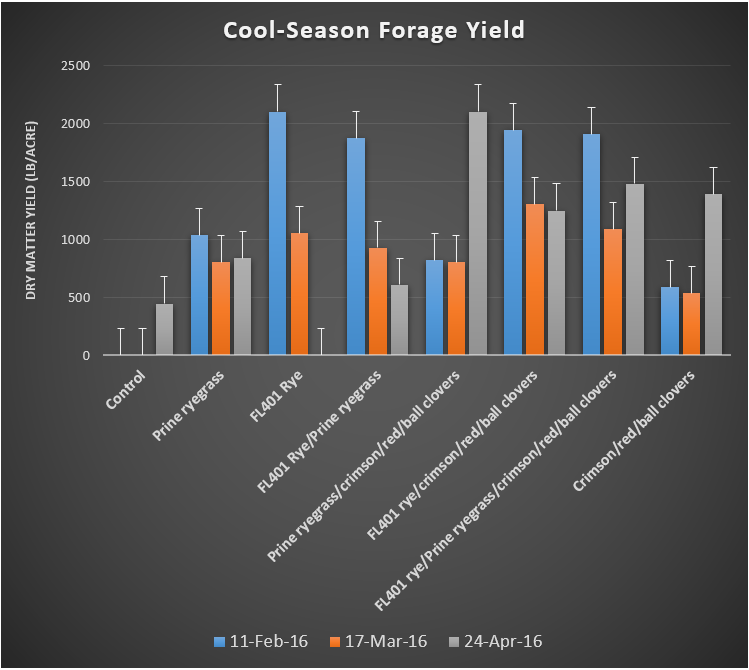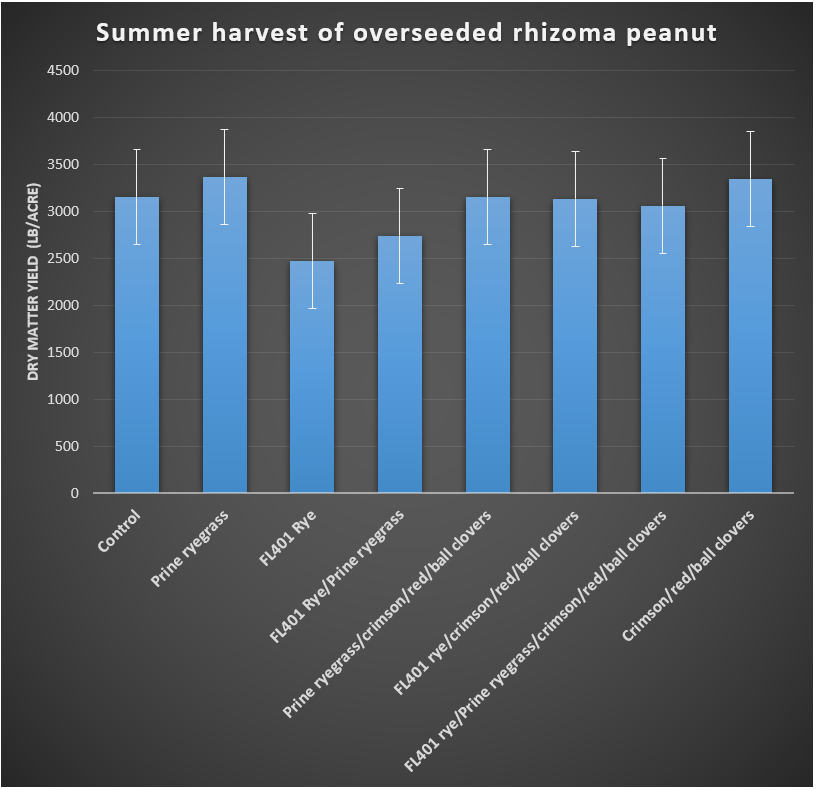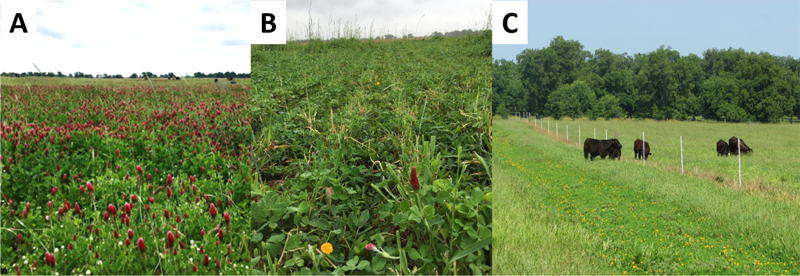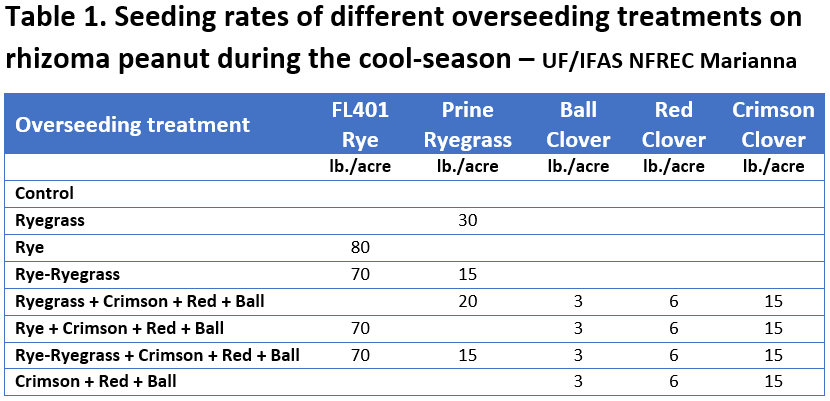Jose Dubeux, Erick Santos, David Jaramillo, Liza Garcia, Luana Dantas, UF/IFAS North Florida Research and Education Center, Marianna
Rhizoma perennial peanut (Arachis glabrata Benth.) is an important hay crop in Florida. Rhizoma peanut hay is locally produced within Florida, and it has important stakes in the horse and dairy industries. This warm-season perennial legume is also a valuable forage option for grazing systems (Dubeux et al., 2018). In addition to adding N via biological N2-fixation, rhizoma peanut has greater nutritive value than most warm-season perennial grasses. As a result, greater livestock performance is achieved when mixing this legume in grazing systems. Many producers using rhizoma peanut want to overseed their field with cool-season forages when the rhizoma peanut is dormant. Common questions that precede the decision to overseed rhizoma peanut fields are: 1) Will it hurt my rhizoma peanut regrowth in the following season? 2) Does it matter which cool-season forage I plant? How about annual ryegrass and clovers? Would they damage the rhizoma peanut because of their late growth in the season?
In order to address these questions, we set up a trial at the UF IFAS NFREC in Marianna, FL. We assessed different overseeding treatments on rhizoma peanut fields, including the control (no overseeding), Prine ryegrass, FL 401 rye, FL 401 rye/Prine ryegrass mix, Prine ryegrass/Crimson/Red/Ball clover mix, FL 401 rye/Crimson/Red/Ball clover mix, FL 401 rye/Prine ryegrass/Crimson/Red/Ball clover mix, and Crimson/Red/Ball clover mix. Seeding rates used are described in Table 1. These different overseeding treatments were applied on a dormant Florigraze sod using a no-till drill in 17 Nov 2015, after mowing the stand down to a 2-inches stubble height. We applied 150 lb/acre of 20-5-20 and 100 lb/acre of Kmag (22% K2O, 22% S, and 10.8% Mg) in all treatments. Plots were harvested three times: 11 Feb, 17 March, and 21 Apr 2016. After the third harvest, plots were fertilized with 300 lb/acre of Kmag. On 22 July 2016, we harvested the rhizoma peanut to assess whether or not the overseeding treatment affected the regrowth.
Overseeding treatments varied their biomass accumulation along the three harvests (Figure 1). Earlier forage types, such as FL 401 rye, produced more in the first harvest, as expected. Treatments with clovers and annual ryegrass produced more biomass later in the season, at the third harvest. The option of forage type or mixtures will depend on the objective of each operation. For hay producers, earlier forage production during the cool-season may free up the land earlier, allowing regrowth of rhizoma peanut without other forages being present. For grazing operations, mixtures would likely be a better option because they would help bridge the gap during the spring-summer transition.

Figure 1. Cool-season herbage accumulation of different overseeding treatments on Florigraze rhizoma peanut; UF IFAS NFREC Marianna; 2016.
In the summer harvest (July 2016), the rhizoma peanut from all treatments, including the control that was not overseeded, produced similar amounts of biomass across treatments (Figure 2). This result demonstrates the viability of overseeding rhizoma peanut fields with cool-season forages. The major aspect to highlight is the importance of timely harvest the cool-season forages during the springtime, allowing the rhizoma peanut to regrow.

Figure 2. Summer herbage accumulation of Florigraze rhizoma peanut after overseed during the cool-season with different forage options. UF IFAS NFREC Marianna; 2016.
We have been overseeding cool-season forages on strip-planted rhizoma peanut in a grazing trial (Figure 3A). We have been doing this for the last three years, and the rhizoma peanut is vigorous and growing (Figure 3C). The critical phase is the springtime, when rhizoma peanut (and bahiagrass) is starting to regrow (Figure 3B). During this transition, it is important to pay closer attention to the grazing management, in order to reduce the canopy density and open spaces to allow the perennial forages (rhizoma peanut and bahiagrass) to regrow.

Figure 3. Overseeding of cool-season forages on strip-planted rhizoma peanut in Marianna, FL. A. Cool-season mixture of FL401 rye-RAM oat-Dixie Crimson-Southern Belle red clover-Ball clover; B. transition period during the Spring; C. strip-planted rhizoma peanut growing during the summer. Photo Credit: Jose Dubeux, UF/IFAS
Take-Home Message
Rhizoma peanut can be overseeded during the cool-season with different forage options without reducing the warm-season regrowth. However, if the cool-season forages form a dense stand during the spring, it is important to graze it off or remove the excess forage with hay equipment. Harvest management during the spring is critical to allow regrowth of the rhizoma peanut.
References:
Dubeux, J., L.E. Sollenberger, J. Vendramini, M. Wallau, A. Blount, L. Garcia-Jimenez, E. Santos, and D. Jaramillo. 2018. Strip-planting rhizoma peanut into grazing systems. EDIS SS-AGR-421. Printer friendly pdf version: https://edis.ifas.ufl.edu/pdffiles/AG/AG42100.pdf
- Grazing Cover Crops is a Triple Win! - August 15, 2025
- How are My Cool-season Forages Recovering from the Snowfall and Low Temperatures? - January 31, 2025
- Integrated Crop-Livestock Systems Improve Soil Health - July 26, 2024

